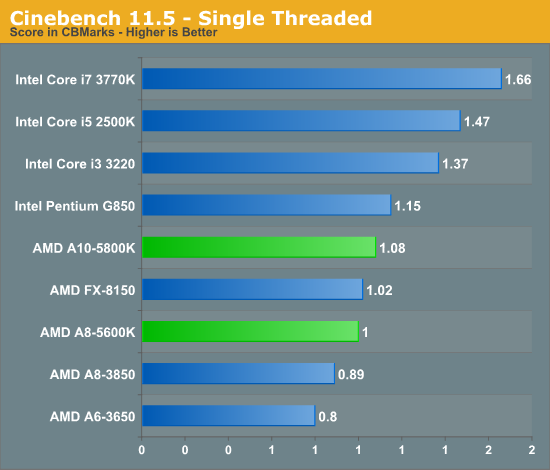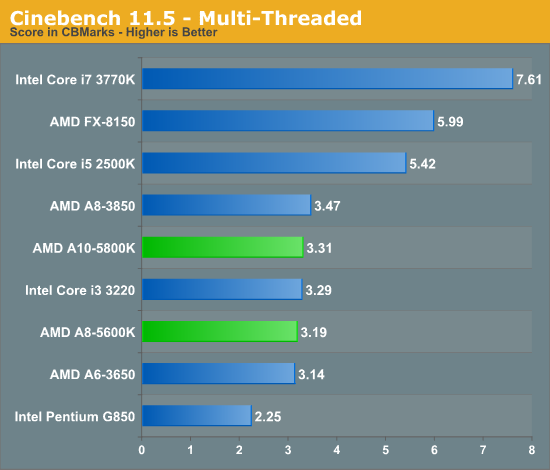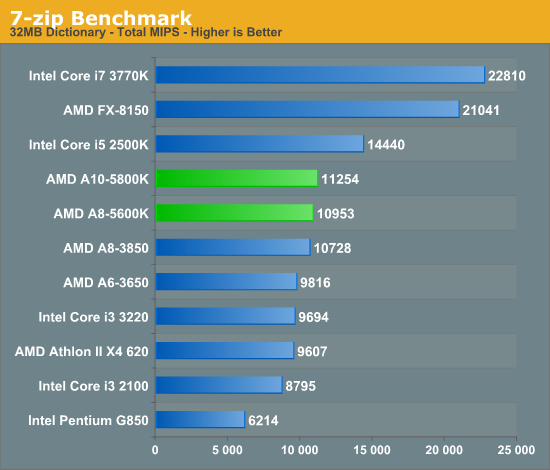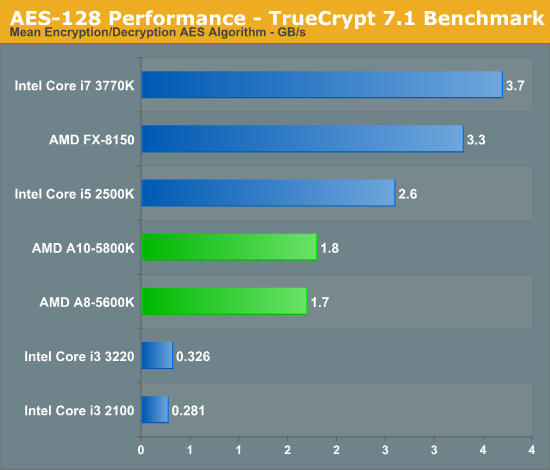AMD A10-5800K & A8-5600K Review: Trinity on the Desktop, Part 2
by Anand Lal Shimpi on October 2, 2012 1:45 AM ESTTrinity CPU Performance: The Good and the Bad
We're going to start our performance investigation a little out of order. The big question on everyone's mind is how much single threaded performance has improved over Bulldozer, and whether it's enough to actually make Trinity faster than Llano across the board. We'll use Cinebench 11.5 as it has both single and multithreaded test options:

The good news is that single threaded performance is definitely up compared to Llano. Piledriver likely has some to do with this, but so does the fact that the A10 can run at up to 4.2GHz (~4GHz typically) with one of its cores active compared to the 2.9GHz clock speed of the A8-3850. Compared to the Bulldozer based FX-8150 there's a slight (~6%) increase in single threaded performance. Although I don't expect anyone will be cross shopping a Trinity APU and a FX CPU, it's important to keep an eye on progress here as we'll eventually get a high-end quad-module/eight-core Piledriver CPU.
Note that compared to even previous generation, low-end Intel CPUs without turbo there's a huge gap in single threaded performance. If we look at the gap AMD has to make up vs. Ivy Bridge it's not pretty. Intel's Core i3 3220 manages a 27% performance advantage over the A10-5800K. Even if Steamroller is able to deliver a 15% increase in performance at the same clock speed, there will still be a gap. And we're not even talking about how Haswell will grow this gap. For the foreseeable future I don't see AMD closing the single threaded performance gap. Jim Keller's job is to fix this problem, but it'll probably take 2 - 3 years to get there.

The multithreaded test shows the other end of reality: in heavily threaded foating point workloads it's possible that we'll see a regression compared to Llano. Remember the Bulldozer/Piledriver architecture prioritizes integer over floating point performance. Truth be told this regression is pretty rare in our tests, but until we get to Steamroller we will still see these types of situations.
Throw more threads at the problem and even with a floating point workload Intel can't pull ahead however. The A10 offers similar performance to the Core i3 3220 at a lower price. Your decision here would come down to the rest of the factors: single threaded performance, processor graphics performance, overclocking capabilities and power consumption. Intel and AMD both win two of those each, it's really a matter of what matters most to you.
A heavily threaded FP workload doesn't really play to AMD's advantages though, what happens when you get a heavily threaded integer workload however? The 7-zip benchmark gives us just that:

Here AMD manages a 16% performance advantage over the Core i3 3220. I'd even go as far as to say that Trinity would likely beat any dual-core Intel machine here. The performance advantage is somewhat artificial as Intel purposefully removes turbo from its dual-core desktop CPUs. This should be AMD's best foot forward, but once again it'll likely take Steamroller for this design to start to make sense.
Speaking of artificial product segmentation, one major feature Intel takes away when you get down to the dual-core desktop i3 level is AES-NI support. Hardware accelerated AES support is something that you get only with the more expensive Core i5/i7s. With Trinity, you get AES-NI support for the entire stack. The result is much better performance in those applications that depend on it:

Like most of the advantages we've talked about thus far, there are really very specific use cases where Trinity makes sense over a similarly priced Intel CPU.










178 Comments
View All Comments
amd4evernever - Sunday, October 14, 2012 - link
http://www.tomshardware.com/reviews/a10-5800k-trin...choke on this..... read first before trolling.. you intel lunatic.
Spunjji - Tuesday, October 2, 2012 - link
Agreed. Ignoring all troll comments that followed this post...C1377 - Friday, July 5, 2013 - link
Just purchased the a10-5800k with a Motherboard for a net cost of $140. Can't beat that price... The Over/Under clock ability is the ace in the hole, as is power consumption when gaming (compared to a discrete graphics solution). For those of us who don't need to game at higher resolutions than 1080p, this setup is great.Beyond that All I need in performance is the ability to encode DVD's faster than my DVD burner, and handle file compression... most of us do work on pc's purchased by our company, and at home we do things like photoshop and DVD authoring. Sometimes I think you guys get so engrossed in the technicalities, that you forget the real world scenarios. How much time am I going to save by the "huge phenominal difference" of 77-70 fps on a DVD encode? I am still going to spend 15-20 minutes burning the DVD, so is a processor which costs an extra $50 worth the shaving down my DVD creation time from 45 min to 42.06783 min? Is this really a "huge phenominal difference" ...only on benchmarks--not in the real world.
gamoniac - Tuesday, October 2, 2012 - link
Anyone who still has not switched to Intel and has AMD's previous high-end chips (eg Phenom II x6) most likely has a high-end graphic card as well, so it makes little sense to switch to a Trinity APU unless one is building a new system or HTPC. I think this fact is hurting AMD, too.Besides that, with AMD having to pitch their top Trinity APU against Intel's i3 chips, I think it is time for AMD to stop any artificial market segmentation on their side. Instead, just make as many high-end APU they can for each TDP bracket and sell them at lower prices. The economies of scale might help bring A10-5800K down to $100, then they would stand a chance against Intel until Excavator cores are out in a couple of years. I don't know... Just a thought. It's painful to see how far the single-thread performance is at this point and Haswell is not even out yet.
fteoath64 - Tuesday, October 2, 2012 - link
Agreed!. AMD should be selling many variants of this APU at different prices. In fact, since Trinity is so highly clocked, it makes the Llano look better, I am gunning for a A8-3870 llano which is just a tab slower than A10-5800 but if Llano can be clocked to 3.3Ghz or 3.5Ghz then it would be a real cracker for the price yet it idles at just as low power consumption. To me, AMD has not made progress since Trinity is highly clocked compared to Llano. If a Llano hits 3.8Ghz, it would blow away the top-end A10 chip which is an embarrassment. We need to compare frequency as well to make clock-for-clock improvements (if any, I can see very few). So, this is why Trinity was artificially delayed to get the Llano parts moving. I can see these Llano parts moving quicker now that the benches are out for all to see.Medallish - Tuesday, October 2, 2012 - link
I don't get your logic, Llano will sell better now that Trinity is out and it's better? No one really cares about clock for clock, there are three major factors here, Price, power, and performance.A10-5800K comes at around the same price and performs better than Llano A8-3870 in pretty much every way.
A10.-5800K uses on average less power than A8-3870, while delivering better performance.
If I buy an APU it's usually based on two factors, CPU and GPU performance, on both of these it's better than Llano while staying within price and power of the previous Llano flagship.
Let me put it in another way, if Haswell turns out to run 4GHz to achieve same speed as a 3GHz Ivy Bridge, but it cost the same, and used 20% less power, would you care at all?
My Desktop is still running Phenom II, I plan on upgrading to Vishera once it's released, no one expected Trinity to be an upgrade for exsisting Enthusiasts using AMD systems, unless they're running something even older and just want something average. Where I plan on using Trinity is in an HTPC. If Iwanted a workstation I think Trinity would make a lot of sense, it sort of makes it all around in terms of work space tasks. For my gaming PC obviously I would stick with a higher end Desktop configuration, but that's not to say that Trinity can't work, we did see gaming reviews last week using a dedicated 7870 and still keep up once the graphics details were pushed.
mikato - Wednesday, October 3, 2012 - link
"...unless one is building a new system..."Uh, isn't this 90%+ or something of CPU purchases? Actually building a new system (for my parents) and maybe an new HTPC (for me) is exactly why I'm interested.
Paulman - Tuesday, October 2, 2012 - link
I just realized that an emerging use case for gamers is live-streaming (or even Fraps'ing) themselves while they play. I'd imagine that's a use case that makes more use of multiple cores, since most games these days only really stress two or so cores?What do you think about eventually introducing a live streaming / video encoding benchmark to represent that use case? (I'm most familiar with Xsplit, as that's what most of the gamers and broadcasters I watch [on Twitch.tv] use)
elhoboloco - Tuesday, October 2, 2012 - link
You should try FFSplit. It's so much easier!Ryan Smith - Tuesday, October 2, 2012 - link
It's worth noting that the moment someone introduces a live streamer with support for Intel's QuickSync and AMD's VCE video encoders, such a benchmark would be made redundant. Those fixed function encoders are designed in large part around real time encoding and completely offload the process, so bogging down the CPU to do real time encoding has effectively been rendered obsolete.